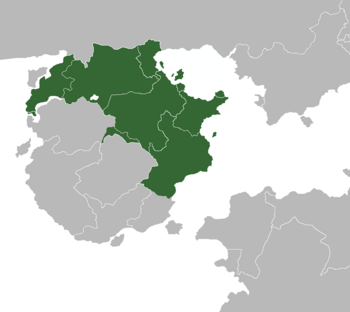Northern Confederation
This article is a work-in-progress because it is incomplete and pending further input from an author. Note: The contents of this article are not considered canonical and may be inaccurate. Please comment on this article's talk page to share your input, comments and questions. |
Northern Confederation | |
|---|---|
| 1660–2009 | |
 The Northern Confederation in 2000 with modern borders | |
| Status | Dissolved |
| Capital | Rotating; typically Kaigwa or Tepetlcali |
| Recognised national languages | Algosh, Housatonish |
| Religion | M'acunism |
| Government | Initially tribal confederation; later constitutional confederacy |
| History | |
• Great confederation | 1660 |
| 2009 | |
The Northern Confederation, officially the Confederation of the Universal North, was a country in Cusinaut.
Etymology
In all applicable languages spoken in the Confederation, and usually in Algosh or Housatonish, the name of the state was the "Confederation of the Universal North". The "Universal North" referred not to a specific relative position on Cusinaut but rather both a perceived astronomical position on earth combined with a mystical directional belief related to the practice of M'acunism. Occidental lack of understanding of the tenets of the religion, combined with a desire for simplicity, usually means the state is rendered simply as the "Northern Confederation" in Julian Ænglish and other Occidental languages.
Geography
The Northern Confederation's boundaries varied over the course of its history. In the most consistent 20th century borders of the Confederation, it occupied a position in Cusinaut extending roughly from its northwesternmost point running southeasterly to the Nysdra Sea in modern New Harren. Accordingly, the Confederation in this configuration occupied about half of Cusinaut. Its position in the 20th century, and throughout most of its history, was oriented toward the Nysdra Sea and for much of its history it ran up the entire eastern seaboard of Cusinaut. Due to the breadth of the Confederation, it varied in climate and topography, though much of its territory sat on a plateau-like relatively flat elevation above sea level. The majority of the Confederation's territory featured a subarctic climate with tundra in the northern extremes and an oceanic climate in the southern extreme.
